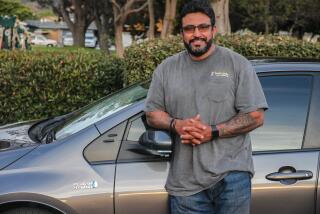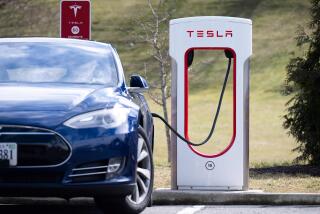Design of the Future
- Share via
Student engineers at Cal State Northridge are putting their design abilities to the test in the Future Car Challenge, a two-year contest sponsored by the U.S. Department of Energy, the U.S. Council for Automotive Research and the Big Three auto makers--General Motors, Ford and Chrysler. Students at a dozen universities throughout North America are trying to design a car acceptable to consumers that gets three times the gas mileage of current cars. The contest is the student version of the Partnership for a New Generation of Vehicles, a national research project involving the private and public sector aimed at designing more fuel-efficient cars.
CSUN students chose to turn their donated Chevrolet Lumina into a hybrid--powered by both a gasoline-burning motorcycle engine and an electric motor. They will get a gauge on their progress when the car is run through a battery of tests June 17-24 in Detroit. The students will have another year to continue working on their projects before final evaluation in June 1997.
The challenge:
The goal of the Future Car Challenge is to design a car that gets 80 mpg.
Other requirements:
250-mile range
0 to 60 mph in less than 16 seconds
Five-passenger seating
Enough trunk room for a small suitcase
Consumer acceptance
Must use technologies with mass production potential by 2004
The execution:
The biggest modification to the car involves replacing its V-6, 3.3-liter engine with a 1.1-liter BMW motorcycle engine and adding an electric motor designed by CSUN students. The gas engine will operate the car on city streets, while the electric motor will be used on the highway. The efficiency gained by the electric motor versus an internal combustion engine should allow the car to reach its 80 mpg goal, despite the fact that it will be weighted down by 575 pounds of batteries in the trunk. “It all comes down to the efficiency of the power,” said Shawn White, a graduate engineering student directing the project. A customized dashboard will display the level of charge in the engine and miles per gallon of both engines. Two solar panels will provide power to a 12-volt engine.
Competition points:
ENERGY ECONOMY
City: 150
Highway: 100
Emissions: 150
Endurance: 100
Acceleration: 100
Handling: 50
CONSUMER ACCEPTABILITY
Static (in showroom): 50
Dynamic (test drive): 100
DESIGN
Technical report: 100
Quality/Execution: 50
Application of Advanced Technology: 100
Manufacturing Potential/Cost: Special Award
READINESS POINTS
Pre-competition inspection: 15
Competition readiness: 35
TOTAL POINTS 1,100
The competitors:
Cal State Northridge
Concordia University
Lawrence Technological University
Michigan Technological University
Ohio State University
UC Davis
University of Illinois at Chicago
University of Maryland College Park
University of Michigan
University of Wisconsin
Virginia Polytechnic Institute & State University
West Virginia University
* Sources: Cal State Northridge engineering department, U.S. Council for Automotive * Research. Researched by STEPHANIE STASSEL/Los Angeles Times






